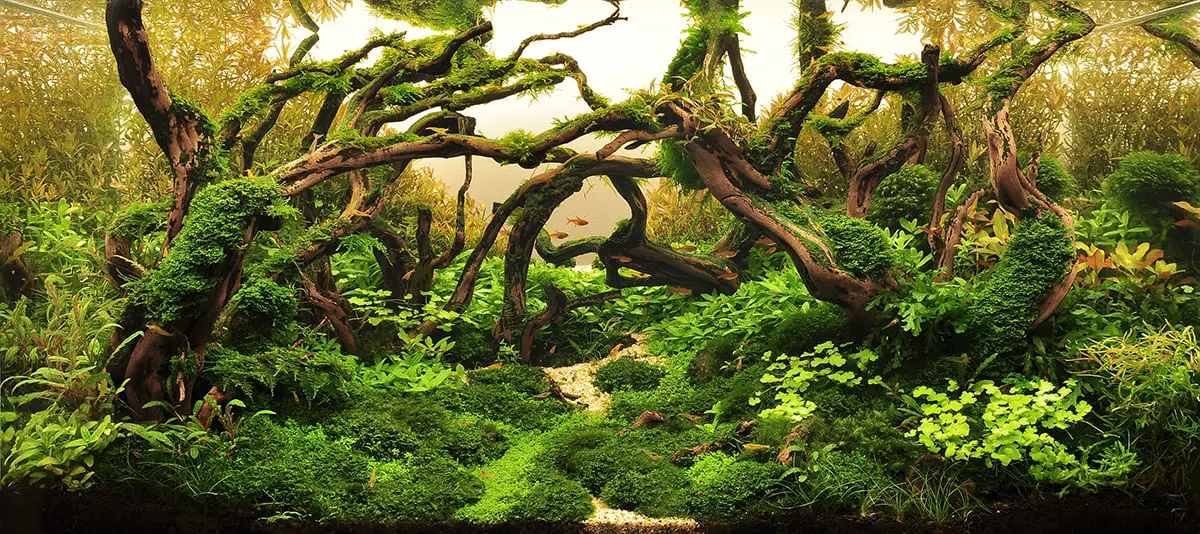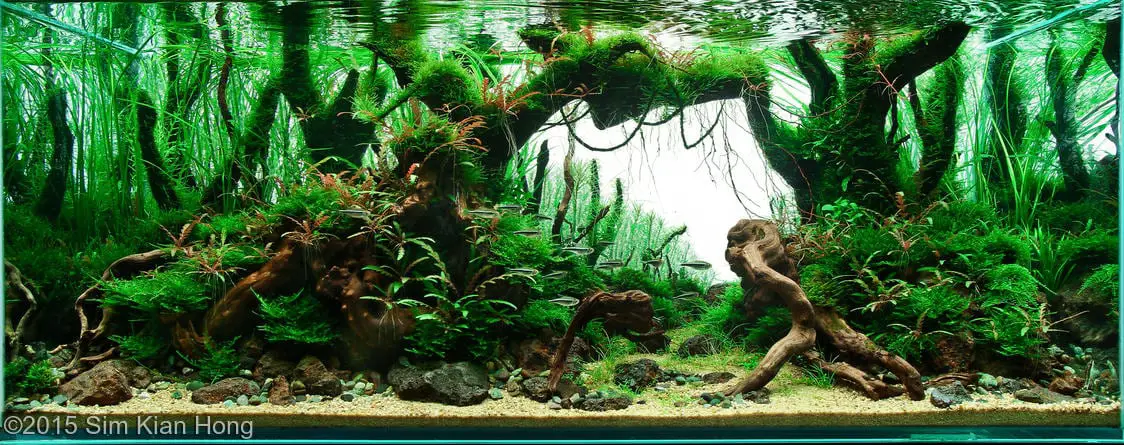Aquascaping is an art that allows you to create a beautiful underwater world in your own home. One of the most popular techniques used in aquascaping is the use of driftwood to create natural and stunning landscapes. Driftwood not only adds a rustic touch to your aquarium but also provides a natural source of shelter for aquatic creatures.
The art of aquascaping with driftwood requires patience, creativity, and an eye for detail. With the right placement and selection of driftwood, you can create a visually stunning and peaceful environment for your aquatic pets. So, whether you’re a seasoned aquascaper or just starting out, learning how to use driftwood in your planted aquarium is a skill that will take your aquascaping to the next level.

The Art of Aquascaping with Driftwood in a Planted Aquarium
Aquascaping is a popular hobby among aquarium enthusiasts, and one of the key elements of creating a visually stunning aquascape is the use of driftwood. Driftwood not only adds a natural look to your aquarium but also provides a surface for beneficial bacteria to grow on, which is essential for a healthy planted aquarium. In this article, we will explore the art of aquascaping with driftwood in a planted aquarium.
Choosing the Right Driftwood
When selecting driftwood for your planted aquarium, there are a few things to consider. First, you want to make sure the wood is aquarium-safe and won’t release any harmful substances into the water. Second, you want to look for driftwood that has a pleasing shape and texture that will complement your overall aquascape design.
One popular type of driftwood used in aquascaping is Malaysian driftwood. This type of wood is known for its intricate shapes and interesting textures, making it a great addition to any aquarium. Another popular option is spiderwood, which has a unique branching structure that can be used to create a stunning focal point in your aquascape.
When choosing driftwood, it’s essential to consider the size of your aquarium and the space you have available. You don’t want to choose a piece of driftwood that is too large or too small for your aquarium.
Preparing Driftwood for Your Aquarium
Before adding driftwood to your planted aquarium, it’s important to prepare it properly to ensure it won’t harm your fish or plants. The first step in preparing driftwood is to soak it in water for several days to remove any dirt or debris.
Next, you want to boil the driftwood for at least an hour to kill any bacteria or parasites that may be present. Boiling also helps to remove any tannins that may leach into the water, which can cause discoloration.
After boiling, you can let the driftwood cool and soak it again for a few days to ensure it’s fully saturated before adding it to your aquarium.
Placing Driftwood in Your Aquarium
When placing driftwood in your planted aquarium, it’s essential to consider the overall design and layout of your aquascape. You want to position the wood in a way that creates a natural-looking environment and complements your plants and other décor.
One popular placement technique is the triangle method, where you place three pieces of driftwood in a triangular pattern to create a focal point in your aquarium. You can also use driftwood to create caves, tunnels, and other hiding places for your fish.
Maintaining Driftwood in Your Aquarium
Once you’ve added driftwood to your planted aquarium, it’s important to maintain it properly to ensure it remains healthy and doesn’t harm your fish or plants. One key maintenance task is to monitor the pH level of your aquarium water, as driftwood can lower the pH over time.
Another important task is to clean the driftwood regularly to remove any algae or other buildup that may occur. You can use a soft-bristled brush to scrub the wood gently, being careful not to damage any plants or other aquarium décor.
Benefits of Using Driftwood in Your Aquarium
There are numerous benefits to using driftwood in your planted aquarium. First and foremost, it adds a natural look and feel to your aquarium, creating a more visually appealing environment. Driftwood also provides a surface for beneficial bacteria to grow on, which is essential for a healthy planted aquarium.
Additionally, driftwood can help to regulate the pH level of your aquarium water, making it a great addition for fish that prefer a slightly acidic environment. Driftwood can also provide hiding places and shelter for your fish, making them feel more secure and less stressed.
Driftwood vs Other Aquarium Decor
When it comes to choosing décor for your planted aquarium, there are many options available, including rocks, plants, and synthetic décor. However, driftwood offers a unique look and texture that can’t be replicated with other materials.
Driftwood also provides a surface for beneficial bacteria to grow on, which is essential for a healthy planted aquarium. While synthetic décor may look appealing, it doesn’t provide the same natural benefits as driftwood.
Conclusion
In conclusion, the art of aquascaping with driftwood in a planted aquarium can be a rewarding and visually stunning hobby. By choosing the right driftwood, preparing it properly, and placing it in a way that complements your overall aquascape design, you can create a natural-looking environment that is healthy and enjoyable for your fish and plants to thrive in.
Frequently Asked Questions
What is aquascaping?
Aquascaping is the art of arranging aquatic plants, rocks, stones, and driftwood in an aesthetically pleasing way in a fish tank or aquarium. The goal is to create a natural and visually appealing underwater environment that is both healthy for the fish and plants and enjoyable for the viewer.
Aquascaping can be done in various styles, such as the Dutch style, the Nature Aquarium style, and the Iwagumi style. Each style has its own distinct features and requires different techniques and materials.
What is driftwood?
Driftwood is a piece of wood that has been washed onto the shore of a body of water by tides, waves, or currents. It can be found in oceans, rivers, and lakes and is a popular material in aquascaping.
Driftwood is valued in aquascaping for its natural appearance and ability to create a natural-looking underwater environment. It can provide hiding places for fish, serve as a substrate for plants to grow on, and help create interesting formations and structures.
How do you prepare driftwood for an aquarium?
Before adding driftwood to an aquarium, it’s important to prepare it properly to avoid any negative effects on the aquatic environment. First, rinse the wood thoroughly to remove any dirt or debris. Then, soak it in water for several days to leach out any tannins or other chemicals that can cause discoloration or harm to the fish.
If you prefer a darker color, you can boil the driftwood for an hour or two to speed up the leaching process. Once the driftwood has been prepared, you can add it to your aquarium and begin the aquascaping process.
How do you incorporate driftwood into an aquascape?
To incorporate driftwood into an aquascape, start by laying out the pieces of driftwood in the aquarium to see how they fit together and what kind of structure they create. Then, add aquatic plants and other materials, such as rocks and substrate, to complement the driftwood and create a natural-looking environment.
When placing the driftwood, consider the needs of the fish and plants, as well as the overall aesthetic of the aquascape. Driftwood can be used to create caves, tunnels, and other hiding places for fish, as well as provide a substrate for plants to grow on.
What are the benefits of using driftwood in an aquarium?
There are many benefits to using driftwood in an aquarium. First, it can provide a natural-looking environment that is both visually appealing and healthy for the fish and plants. Driftwood can also help create interesting formations and structures that add depth and dimension to the aquascape.
In addition, driftwood can serve as a substrate for plants to grow on, which can help oxygenate the water and improve the overall health of the aquarium. Finally, driftwood can provide hiding places for fish and other aquatic creatures, helping to reduce stress and promote healthy behavior.

#03 Step by Step Aquascaping Tutorial (120L)
In conclusion, the art of aquascaping with driftwood in a planted aquarium is a beautiful and rewarding experience. By using natural materials to create a unique and harmonious underwater landscape, you can create a peaceful and serene environment for your aquatic pets to thrive in.
Driftwood is a versatile material that can be used in many ways to create different effects in your aquarium. Whether you want to create a natural-looking forest, a rocky outcropping, or a minimalist design, driftwood can help you achieve your vision.
Finally, remember that aquascaping is an art form that requires patience, creativity, and attention to detail. With practice and a willingness to experiment, you can create a stunning and unique aquarium that reflects your personal style and love of nature. So why not give it a try and see where your imagination takes you?
